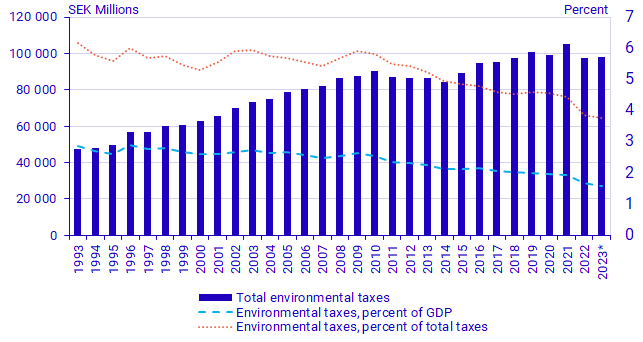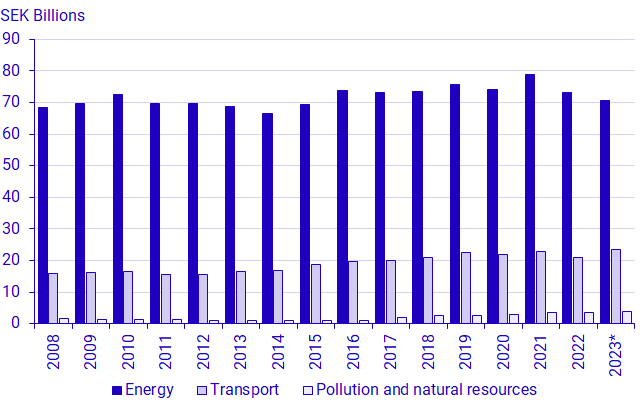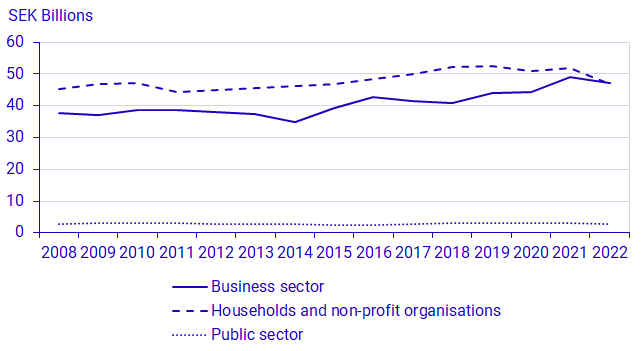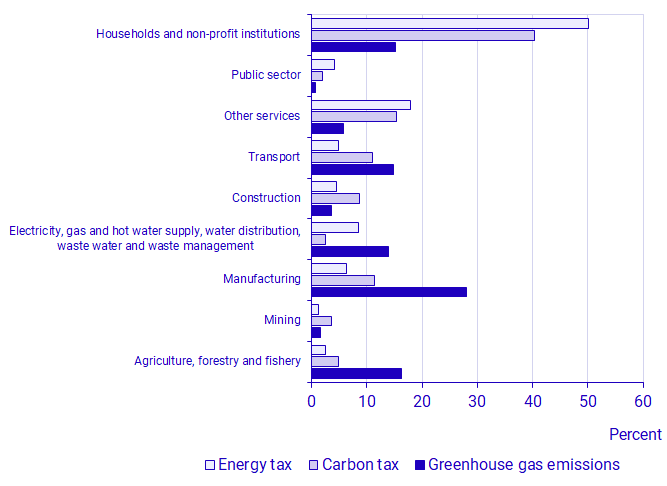Environmental taxes 2023 and industry allocated environmental taxes 2022
Environmental tax revenue increasing in 2023
Statistical news from Statistics Sweden 2024-06-20 8.00
In 2023, environmental tax revenue amounts to 98 SEK billion which is an increase of 485 SEK million compared with the previous year. Total environmental taxes as a share of GDP continues to decrease.
Sweden’s total environmental tax revenue amounts to 98 SEK billion in 2023, representing 1.58 percent of Swedish GDP. In 2023 governmental tax revenues from environmental taxes increase by 130 SEK million compared with 2022. This is a relatively small change compared to the previous year.
– A clear trend is that environmental tax revenues as a share of GDP is continuing to decrease and amounts to 1.58 percent of GDP in 2023. This implies that environmental taxes have increased at a lower rate than the economy and total tax revenue, says Frida Hellman, analyst at Statistics Sweden.
The total environmental tax revenue as a share of GDP has shown a decreasing trend since 2016. In that year environmental tax revenues amounted to 2.15 percent of GDP. Total environmental tax revenue has however more than doubled since 1993.

* GDP and total taxes are preliminary.
Energy taxes contribute most to environmental tax revenue
Environmental taxes are divided into four categories: energy, transport, pollution, and natural resources. Energy taxes contribute the most to the environmental tax revenue. They account for 71 percent of total environmental taxes in 2023. Energy taxes consist among others of energy tax on fuels, carbon dioxide tax and energy tax on electricity. Transport taxes contribute with the second highest revenue. Transport taxes account for 24 percent of total environmental tax revenue in 2023 and they consist among others of vehicle tax, congestion tax and tax on air travel.

* Total taxes and taxes allocated by industry are preliminary.
Households and businesses contribute the most towards carbon and energy tax revenues
The last reference year for industry-allocated environmental taxes is 2022, where households and the business sector are paying approximately the same share of the total environmental taxes. There are however differences regarding which type of taxes they are paying. Businesses pays 56 percent of the carbon tax while households pay 41 percent. The shares for the energy tax are 46 percent from businesses and 50 percent from households.
Meanwhile, businesses emit 84.1 percent of Sweden’s greenhouse gas emissions in 2022 whilst households’ emissions account for 15.1 percent.


Revisions
The production of environmental taxes in 2024 led to revisions, primarily for the years 2021 and 2022, due to a comprehensive review of the national accounts. One such amendment was related to the electricity fuel tax, which was adjusted downwards for both 2021 and 2022. Additionally, the values for the NACE Industry C were revised upwards. The share of environmental tax revenues at the industry level for 2021 and 2022 is partially based on the proportions from 2021, prior to the comprehensive review. More information can be found in the quality declaration (only available in Swedish as Kvalitetsdeklaration).
In 2024, a new method for calculating emission allowances (ETS) was introduced for production. Instead of sourcing data from the FRIDA database, it is now gathered from the Environmental Protection Agency.
Definitions and explanations
The definition of an environmental tax used by Statistics Sweden derives from the definitions of Eurostat and the OECD. It is found in the global statistical standard for environmental accounts, SEEA Central Framework, and enables comparative studies between different countries. Eurostat's definition of an environmental tax is:
“A tax whose tax base is a physical unit (or a proxy of a physical unit) of something that has a proven, specific negative impact on the environment, and which is identified in ESA as a tax."
According to this definition, it is the tax base and not its motive or name that determines whether the tax is an environmental tax. ESA refers to the European System of Accounts and refers to the guidelines for calculating National Accounts.
Next publishing will be
June 2025.
Feel free to use the facts from this statistical news but remember to state Source: Statistics Sweden.
